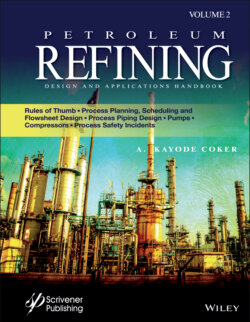Читать книгу Petroleum Refining Design and Applications Handbook - A. Kayode Coker - Страница 16
CONVEYORS FOR PARTICULATE SOLIDS
Оглавление1 1. Screw conveyors are suited to transport of even sticky and abrasive solids up inclines of 20° or so. They are limited to distances of 3.81 m (150 ft) or so because of shaft torque strength. A 304.8 mm (12 in.) diameter conveyor can handle 28.3–84.95 m3/h (1000–3000 ft3/h), at speeds ranging from 40 to 60 rpm.
2 2. Belt conveyors are for high capacity and long distances (a mile or more, but only several hundred feet in a plant), up inclines of 30° maximum. A 609.6-mm (24 in.) wide belt can carry 84.95 m3/h (3000 ft3/h) at a speed of 0.508 m/s (100 ft/min), but speeds up to 3.048 m/s (600 ft/min) are suited to some materials. Power consumption is relatively low.
3 3. Bucket elevators are suited to vertical transport of sticky and abrasive materials. With 508 × 508-mm (20 × 20-in.) buckets, capacity can reach 28.3 m3/h (1000 ft3/h) at a speed of 0.508 m/s (100 ft/min), but speeds up to 1.524 m/s (300 ft/min) are used.
4 4. Drag-type conveyors (Redler) are suited to short distances in any direction and are completely enclosed. Units range in size from 19.4 × 10−4 to 122.6 × 10−4 m2 (3–19 in.2) and may travel from 0.15 m/s (30 ft/min) (fly ash) to 1.27 m/s (250 ft/min) (grains). Power requirements are high.
5 5. Pneumatic conveyors are for high capacity, short distance (122 m (400 ft)) transport simultaneously from several sources to several destinations. Either vacuum or low pressure 0.4–0.8 barg (6–12 psig) is used with a range of air velocities from 10.7 to 36.6 m/s (35–120 ft/s); depending on the material and pressure and air requirements, 0.03–0.2 m3/m3 (1–7 ft3/ft3) of solid is transferred.
